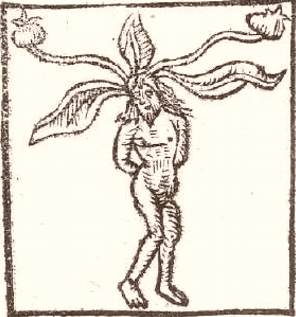Thursday, June the 23rd, 2005
back to: title, date or indexes
The “insane root” which Mrs Campbell Praed refers to in the above quotation is likely to be a mandrake. The bifurcated root of the plant resembles a human figure, or so people have thought throughout the ages. There is a legend that when the mandrake-person is pulled from the ground, it shrieks in pain, and this cry is able to madden, deafen or even kill an unprotected human being. One way of pulling a mandrake out of the ground safely is given as follows: “A furrow must be dug around the root until its lower part is exposed, then a dog is tied to it, after which the person tying the dog must get away. The dog then endeavours to follow him, and so easily pulls up the root, but dies suddenly instead of his master. After this the root can be handled without fear.”
Being a miniature person, the mandrake root is thus a type of homunculus. The first homunculus was made by that old rascal Paracelsus out of a bag of bones, sperm, skin fragments and animal hair, these ingredients laid in the ground surrounded by horse manure for forty days, at which point the embryo formed. It seems likely that Paracelsus was making this up, as I tried it. I was looking forward to having a little homunculus running about the place, and was even thinking up a suitable name for it, but when I dug up the patch of manure there was no sign of any such being.
The mandrake itself features in another homunculus “recipe”. The root has to be picked before dawn on a Friday morning by a black dog, then washed and fed with milk, honey and blood. I was going to try this approach too, but I was unable to find a suitable dog.

A particularly thrilling method of creating a homunculus was given by Dr David Christianus of Giessen in the eighteenth century. He suggested taking an egg laid by a black hen, poking a tiny hole through the shell, replacing a bean-sized portion of the white with human sperm, sealing the opening with virgin parchment, and burying the egg in dung on the first day of the March lunar cycle. Do this, he confidently announced, and after thirty days a miniature humanoid would emerge, which would help and protect its creator in return for a steady diet of lavender seeds and earthworms. I am going to have a bash at this method next March and will let readers know how I get on.
Hooting Yard on the Air, June the 29th, 2005 : “Shem, Ham, Japheth and Minnie Crunlop” (starts around 22:08)
Hooting Yard on the Air, November the 1st, 2006 : “Sieves and Basins” (starts around 12:48)